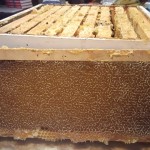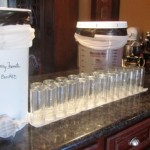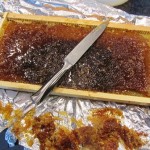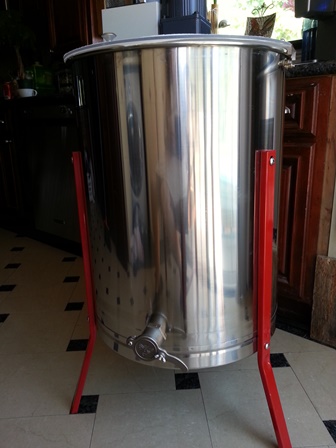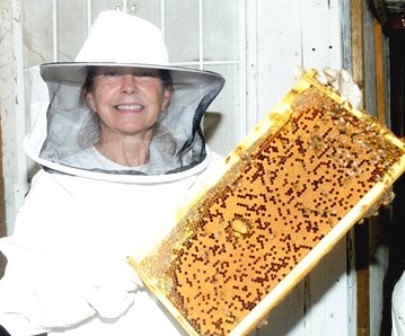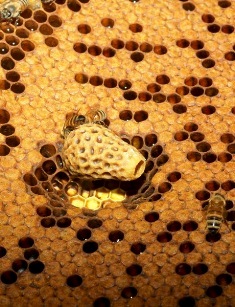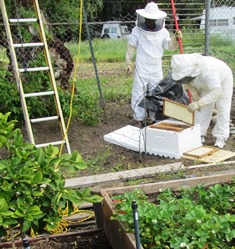Harvesting Honey–Helping Hands Always Welcome
When it comes to opening the hives of honey bees here on our farmette, I’m grateful for the helping hands of my hubby and my neighbor. Carlos, my hubby and helpmate for life, is my go-to guy for all our farm projects. And our neighbor Peter not only has answers to my questions about bees, but also he can open a hive, remove frames of honey, inspect and medicate, and seal the unit lickety-split.
With the smoker at the ready and lit, we opened our hives September 23, 2018. The hives were robust, but the bees appeared stressed. I had added supers to each hive in late July but should have kept a closer eye on the burgeoning bee population. They had become overcrowded and hungry.
For harvesting, we first removed the heavy metal lid of the hive box, replacing it with a fume board. A fume board is a lid lined with fabric that is sprayed with a product that encourages the bees to vacate the supers (some bees immediately leave the box; others go into the brood chambers). The fume board works within seven to ten minutes. We then pulled out the frames of honey, gently brushed off any remaining bees, and took the honey-heavy frames to the kitchen.
For an old hand at beekeeping like my neighbor, the process went quick. Not so for me. This past year, I injured both my shoulders with tears in the rotator cuff tendons. With limitation to some of my range of motion, I’ve felt pretty handicapped. Still, I helped by carrying a single frame of honey at a time from the hive box to the kitchen.
While the hives were open, we removed old medicated strips previously hung in the boxes to thwart mites.
- Small sheets for trapping hive beetles are placed across the frames in the top super before closing the lid
We also replaced the Bee-Gone sheets to trap hive beetles. It’s important to properly handle such items and to keep the apiary clean. We put in medication for mite control–a white gelatinous substance spread on a paper similiar to an index card. Finally, we placed a single patty of bee food on the frames to provide for the bees’ nutritional needs.
The bees immediately coalesced on the patty; no longer stressed, they seemed gentle and calm. Checking the bottom frames, we found a lot of brood (eggs, larvae and pupae of bees). To help this new generation of honey bees along, we inserted an unopened frame of honey that I’d kept wrapped in foil and frozen (freezing kills any insects that could infect the hive or bees). Honey, of course, is the perfect food for them.
We will reopen the hives in two weeks and re-check the status of the bees. A that time, we’ll treat with an antibiotic for winter and possibly add a super if necessary.
I haven’t yet processed the honey we harvested but the frames are on my kitchen counter. They are in a hive box wrapped in aluminum foil. At the ready are also several food-grade buckets that I’ve carefully washed, dried, and covered with lids. The honey spinning machine has been cleaned. Before I begin working with the honey in the frames, I always scrub my kitchen, washing the countertops twice–first with soap and water and then with diluted bleach and hot water.
When everything is clean, I will begin to work on each frame. I first scrape away any bee “glue” from the outside edges of the frame. With a hot knife, I slice all around the interior edges before opening the sealed wax cells (sliding the hot knife just under the wax and lifting). Both sides of the frame are dealt with in this manner. After the wax cells are uncapped, the frame will be placed into the spinning machine. It uses centrifugal force to spin off the honey. The sweet stuff then drains through the strainer material taped around the bucket mouth. The bucket is positioned under the machine spigot.
My reward for this labor of love is having an abundance of sweet, amber honey when desired to bake a honey cake or other culinary creation, to enjoy a relaxing cup of tea, or to fill jars for holiday gift-giving. Beekeeping draws people together and, take it from me, a helping hand is always appreciated.
_______________________________________________________________________________
If you enjoy reading about keeping bees and chickens, growing heirloom vegetables and fruits, or living the farmette (small farm) life, check out my offering of books that tie into themes of living well and close to the Earth.
Grab one or more of my cozy mysteries (no gratuitous sex, profanity, or violence) and discover delicious farm recipes, gardening advice, and tips for caring for bees and chickens.
Or pick up one of my wellness, spirituality, or manifesting books. They make great holiday gifts for yourself and others.
All my books are available in traditional bookstores everywhere and also online at Amazon.com, Barnes & Noble (barnesandnoble.com), Kobo Books, Walmart, and other retailers.
For more information, click on the following URLs:
A HIVE OF HOMICIDES
MURDER OF A QUEEN BEE
A BEELINE TO MURDER

More than 150 rituals for sound mind, strong body, and meaningful connections to the people around you
https://www.amazon.com/dp/B0719HHVRJ/ref=dp-kindle-redirect?_encoding=UTF8&btkr=1
Spinning Liquid Gold
Honey is the liquid gold that we harvest from our backyard honeybee hives. Until recently, I had to take frames out of the hives, open the cap cells, and drain the honey through a strainer into a bucket.
Just before Mother’s Day, my hubby purchased an electric honey extractor. He set it up in the kitchen. This weekend, we plan to open the hives and harvest some frames, giving our new machine a test run.
A hand-cranked or electric honey extractor makes it much easier to get honey out of the wooden frames. After the capped cells are opened with a hot knife, the frame goes into the machine. It spins honey against the cylinder walls and the sweet liquid then drains out the spigot.
I use a fabric paint strainer taped over a five-gallon honey bucket (also with a spigot) to filter the honey and fill the jars. The jar of liquid gold is then labeled and ready to distribute to customers and friends.
* * *
If you like reading about keeping bees and chickens, harvesting honey, and creating delicious recipes, check out my novels in the Henny Penny Farmette series. Besides offering an intriguing cozy mystery, these books are chocked full of farm sayings, tips for gardening, yummy recipes, and much more.
My novels are published by Kensington Publishing and are available through online stores of Barnes & Noble, Amazon.com, Walmart, Kobo and conventional bookstores everywhere.
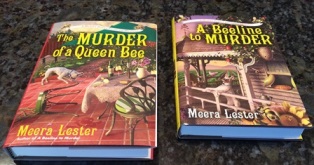
A BEELINE TO MURDER is the debut novel and THE MURDER OF A QUEEN BEE is the second book in the Henny Penny Farmette series from Kensington Publishing.
Swarming Season Has Arrived!
What’s not to love about spring? It’s only the middle of April and already we’ve seen several honeybee swarms. Swarming is how the bees reproduce their colonies and most often occurs during the warm days of early spring.
My neighbor, whom I’ve often called a world-class beekeeper (his father kept honeybees in Lebanon and taught him well) permitted me to keep his bee swarm that alighted in my apricot tree. He also generously donated a super (hive box) with some frames that already had wax, honey, and capped brood–all from his own apiary.
The newly housed honeybee workers delight in foraging on the various types of lavender (Spanish, English, and French perfume) that I’ve planted around the farmette. The colony will build up the wax and make honey while the nursemaid bees will care for the brood.
My husband, the architect-turned-farmer/beekeeper, has constructed a unique bee house for the hives. It will keep the bee boxes dry during winter rains and out of reach of marauding animals (skunks and raccoons). Resting on a platform that Carlos built on top of a newly installed brick floor, the hives are not within easy reach of the ever present ant population.
Alas, the bees weren’t about to wait until Carlos finished building their house. The swarm happened when the bees were ready to take flight (some 60 percent of the workers with their old queen) flew into our apricot tree.
If you see a swarm, call your local beekeeping association (or any store that carries local honey) for the name of a beekeeper. Avoid the temptation of spraying water or anything else on the swarm. Permit the beekeeper to safely remove the swarm.
For a beekeeper, rescuing a swarm is a truly exhilarating experience. Often a swarm consists of thousands to tens of thousands of honeybees. Beekeepers routinely rescue swarms from where bees have temporarily clustered while the bee scouts seek a permanent home. The beekeeper can shake them into a prepared hive box, leaving the box at the hive cluster site until all the bees are inside. At that point, the beekeeper takes the new hive to his apiary.
The beleaguered honeybees (whose populations have been decimated by the Varroa mite, weakened immune systems, and Colony Collapse Disorder) need help to survive and increase their populations. We need them, too! Without their pollination of fruit, nut, and other crops, our own food sources diminish.
Saving the honeybees is a good practice whenever possible because doing so ensures abundance and diversity in the plants we eat. Whenever I see a cluster of bees in a tree I feel joyful and celebratory. Is it any wonder that swarming season is my favorite time of the year?
 Facebook
Facebook Goodreads
Goodreads LinkedIn
LinkedIn Meera Lester
Meera Lester Twitter
Twitter



